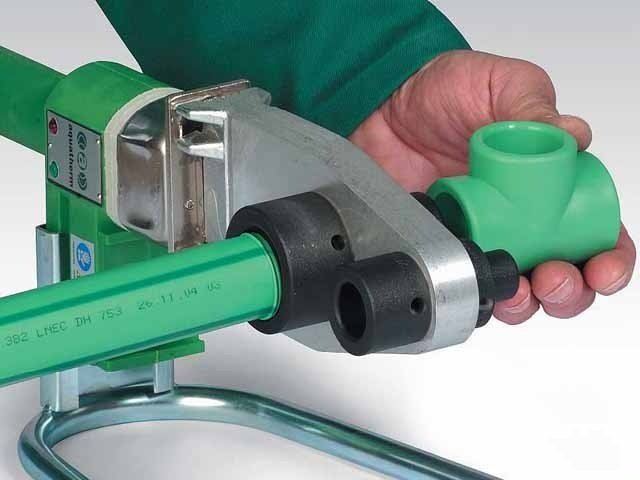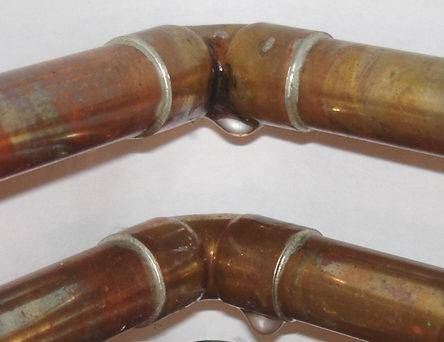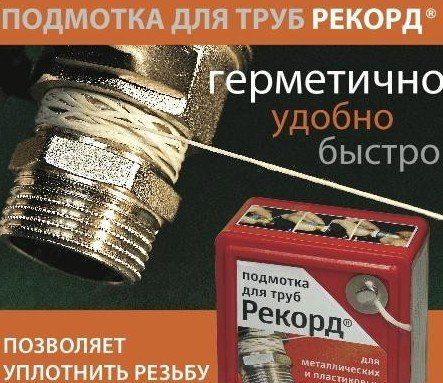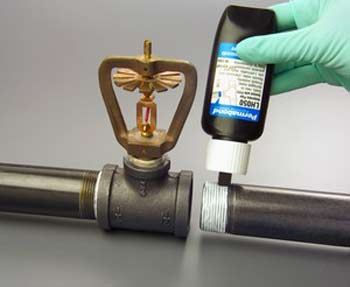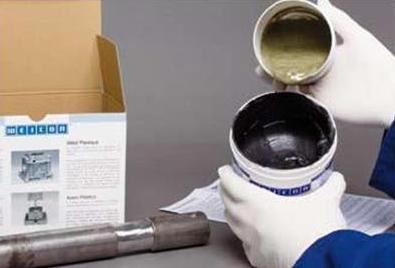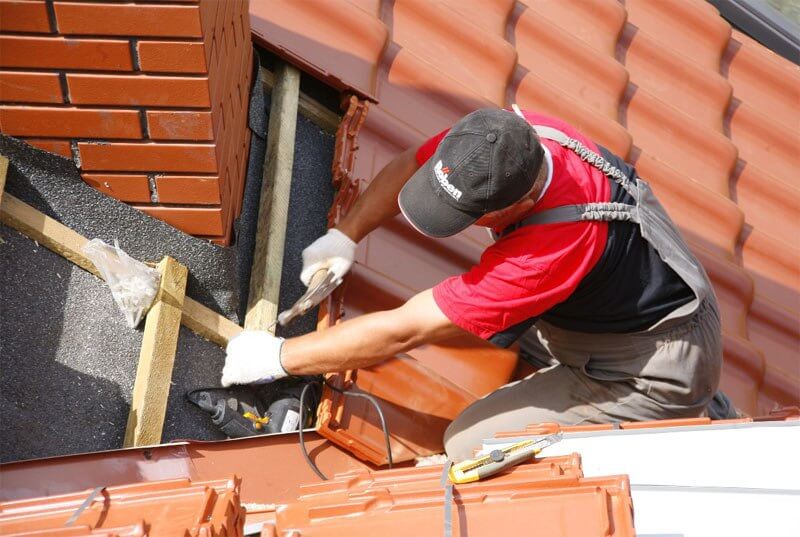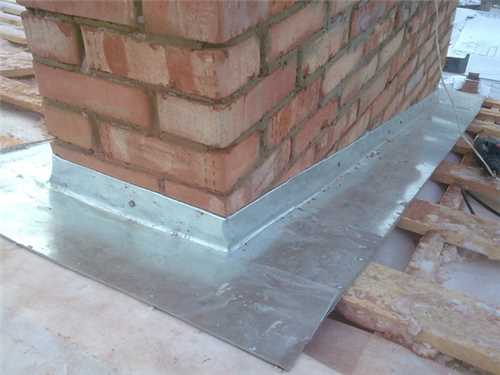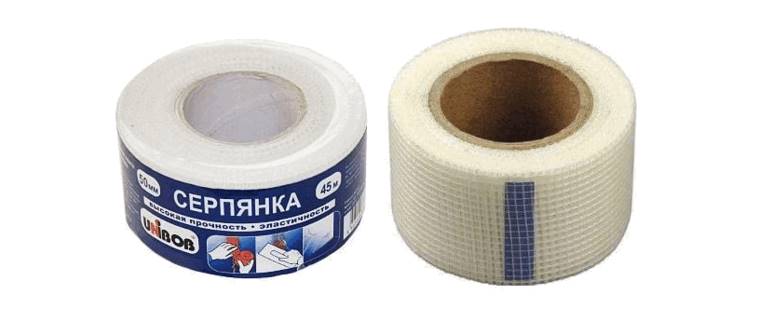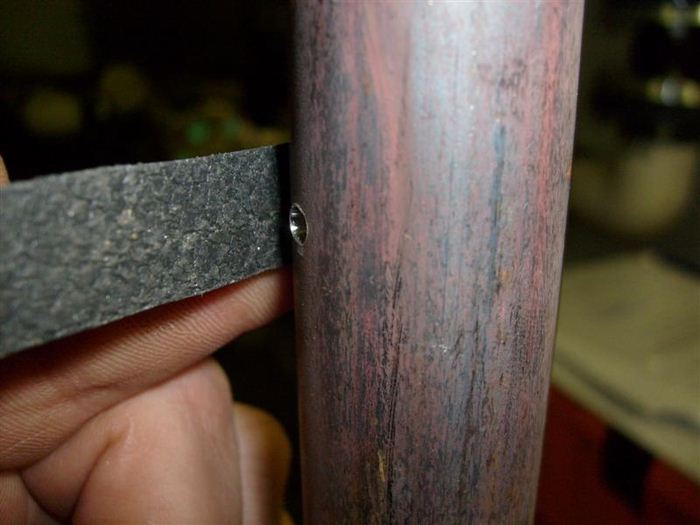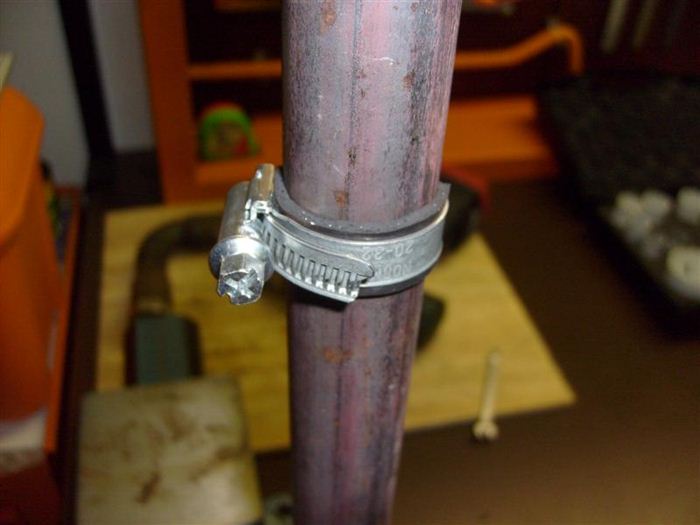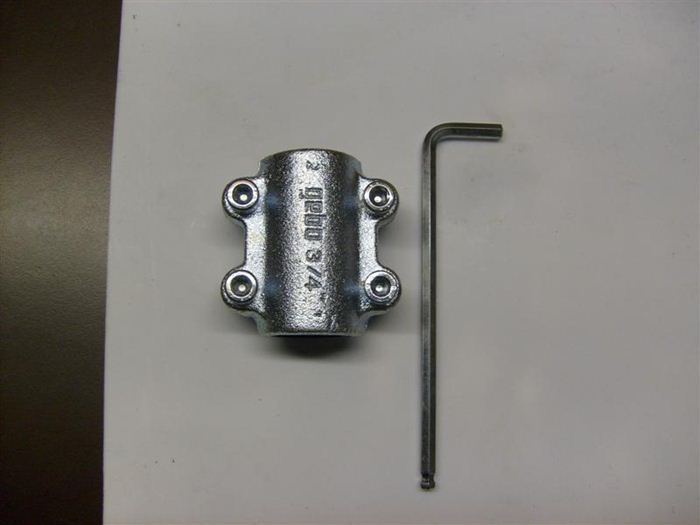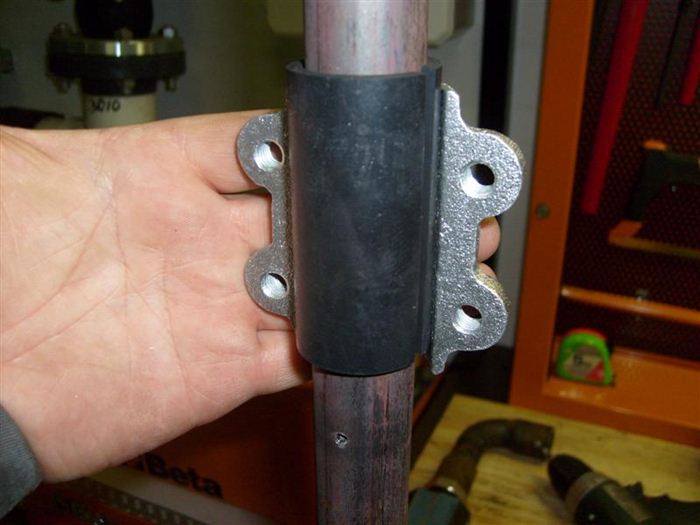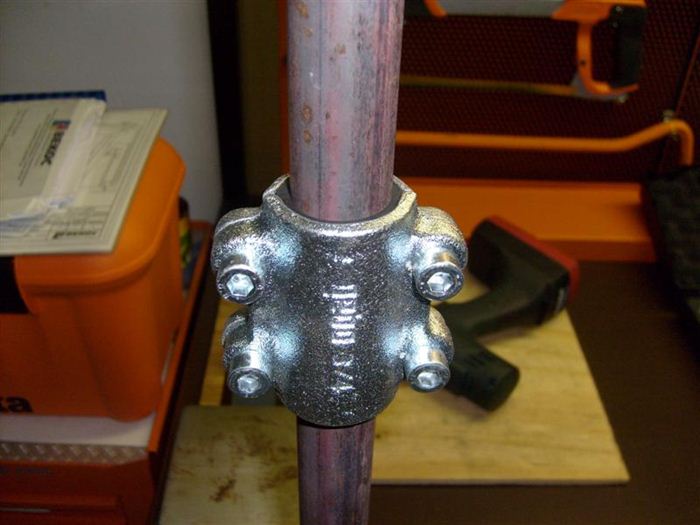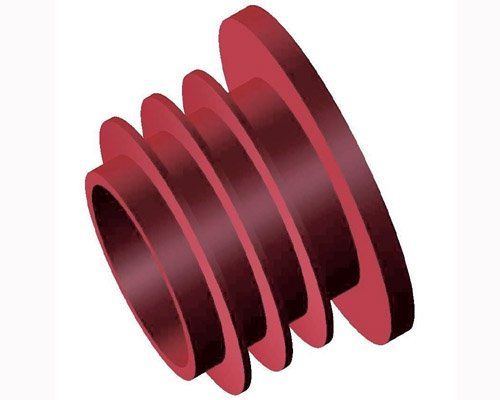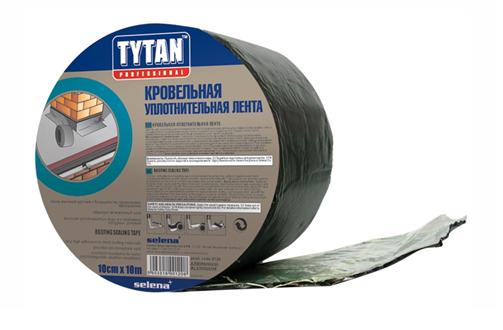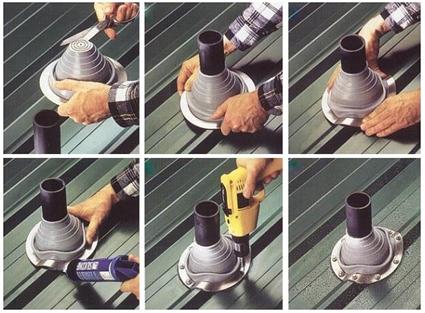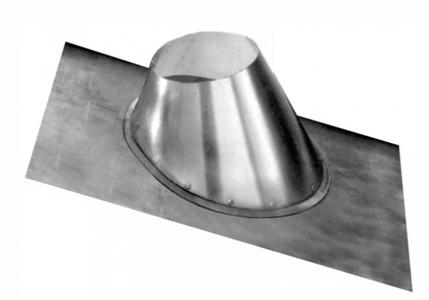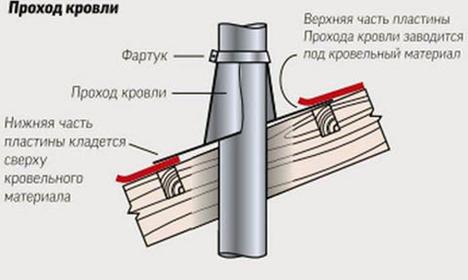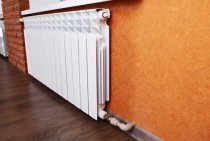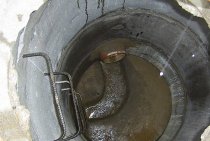Replacement of the damaged area
It is often possible to eliminate a leak only by replacing the damaged piece of pipe with a whole one.
Required tools and parts: hacksaw; linen; pipe wrenches; sealing putty; clutch; pipe cutter; cap nut.
Progress
- Cut out a pipe section with a leak + 30 cm with a hacksaw for metal.
- Unscrew the threaded connections, clean the threads, remove the cut piece.
- We cut the thread on the old pipe. To do this, hold it with a pipe wrench. This will prevent the pipe from deforming and twisting.
- We screw the coupling onto the fixed pipe coupling and find out the length of the pipe to be replaced, taking into account the length of the thread.
- Having fixed the pipe with a vice, we saw off the required length with a pipe cutter.
- Let's cut a thread on it with a screw.
- Having wound flax on the thread, we seal it and lubricate it with sealing putty.
- Connect the new pipe to the old pipe with a pipe coupling.
- With a cap nut, connect the new pipe to the old one at the other end.
Replacing a pipe section
For emergency repairs, the pipe can be wrapped with rubber from a bicycle tube and secured with couplings until a major overhaul.
Repair of cast iron pipes
We seal the joints of cast-iron pipes:
- winding strands;
- sediment strands;
- putty with asbestos-cement mortar.
But first you need to clean the pipe to bare metal.
If the service life of the sewer pipes has expired, the system must be dismantled:
- we cut the pipe with a grinder to the joint;
- from the socket we remove the remnants of stuffing, cement;
- on the remaining section of the pipe with a grinder, we make transverse cuts - an emphasis for the lever;
- insert the mount into the grooves formed and loosen it along the axis of the pipe;
- we take out the rest of the pipe from the socket;
- we put a rubber coupling-adapter in the socket;
- put a plastic pipe in it.
Repair of plastic pipes
- If the surface of the plastic pipe is damaged, repair is not desirable due to its unreliability and low cost.
- The question of how to cover up a sewer pipe, its slight damage is solved in a modern way simply: with a sealant.
- Additionally, fittings can be cut in. Tees are suitable for tapping into a sewer pipe (see details on welding polypropylene pipes).
- In case of a leak at the joint, it is necessary to replace the deformed seals by lubricating the new ones with silicone.
Soldering plastic pipes
If the sewer pipe is leaking (see also how to fix a leak in a heating pipe), you can easily and quickly eliminate the leak using the indicated improvised means and self-confidence or make a replacement sewer pipes in the apartment.
http://o-trubah.ru
Locating a pipe
The most suitable place for the output of the pipe is the ridge.
It is necessary to determine the location of the furnace at the construction stage. In addition to having a well-fortified foundation under it, it should be remembered that it is better not to put a large number of beams and rafters above the location. After all, the presence of a chimney, which is a very heavy element, suggests the location of good supports for it. Also, do not forget that the longer the section of the straight chimney pipe, the higher the draft level. But it also reduces the efficiency of the boiler or furnace.
It is important to find the best ratio between heat transfer and thrust.
Also, the quality and strength of traction depends on the wind, so it is best to bring the pipe out in the area where the ridge is located. The presence of a cap (an extension in the upper part of the chimney) also helps to improve traction. Good thermal insulation prevents condensation, and the pipe is best made from materials that warm up quickly.
Causes of accidents
Repair of sewer pipes takes place in emergency situations. Accidents are different, which means that they need to be eliminated in different ways.
Over time, a leak can form even in well-installed pipes made of durable materials.
If a sewer pipe leaks due to mechanical damage, a major overhaul is inevitable: replacement of the entire pipe or part of it. When the connection is depressurized, minor repairs can be dispensed with.
Sewerage leaks, as a rule, due to damage to pipes or defects in their production, as well as at the joints.
If the sewer pipe flows at the junction, you must:
- dry the joint;
- clear of clogging, cement or glue;
- seal the gap between the pipes with sanitary linen winding;
Waterproofing pipe winder
- generously cover with plumbing sealant;
- Do not use the sewer for 5 hours.
Instant pipe sealing
- Crack in coating. The problem of how to eliminate a leak in a sewer pipe if it goes through a cracked solution is solved as follows: after drying, we cover all cracks with silicone, epoxy, liquid rubber and even plasticine.
- Fistula. If water flows out through a fistula in the pipe, then temporarily you can drive a short wooden wedge into it - a chop or a lead cone, then wrap the pipe with rubber or bandage and then impregnate it with epoxy, or make a clamp. Installing a clamp, even a homemade one, is the most reliable option.
Epoxy Liquid Crack Compound
Roof gap patching
After removing the pipe to the street, you can proceed to its termination on the roof. The main problem in this case is to protect the resulting gap in the roof from leaks. There are several methods to protect the resulting gaps from leaks. The traditional method involves the construction of an apron. During its construction, adjoining strips will come in handy. They will be located at the bottom of the pipe. According to the plan, these strips are applied to the chimney pipe and the contours of its upper part are already marked directly on its walls.
To seal the chimney, an apron is installed to the junction of the pipe and the roof.
To form the required strobe along the marked line, they are passed by a grinder. At the same time, the installation of the inner apron begins precisely from the bottom of the pipe, while leading the edge of the bar directly into the strobe. Subsequently, with the help of an overlap, other elements of the apron are assembled. In this case, the size at the overlap of the parts should be about 15 cm. At the same time, the edges of the plank that were inserted into the strobe are covered with a special sealant. In this case, the lower parts of the bar can be cut and attached with self-tapping screws. This is followed by sealing the gap between the roof and the pipe. This is the construction of the so-called tie. For this, a waterproofing material is taken, which is installed directly under the lower element of this apron. This is necessary to drain water. At the same time, it is installed so that the liquid goes into the gutter elements of the roof.
Already on top of the installed elements, the roofing part is mounted and an external tie is placed. When mounting it, you should follow the scheme for setting the inner tie. The only difference is that the upper strips will adjoin the pipe without being introduced into the strobe. However, the above is not the only solution to this problem.
In the presence of a round chimney pipe, a special universal nozzle can be used. It is designed to seal various elements and is used not only for pipes, but also for removing antennas, ventilation, and lamps. At the same time, it resembles a stepped pyramid. Made of silicone and rubber, while the base is aluminum
At the same time, it is worth paying attention to the fact that if the nozzle is made of rubber, then its performance characteristics range from -50 to + 130 degrees. In the presence of a silicone model, it is worth remembering that its thermal characteristics are even wider and range from - 70 to + 250 degrees
Due to this, the seal can be used with any roofing material. Not only is it easy to install, but it also lasts a long time.
Best Answers
Yuri Russian:
In most of Russia, clay was always taken from cellars, ravines, and rivers. For one-piece joints of a metal chimney, a sealant for automobile mufflers is very well suited, - as an option - cold welding for automobile cylinder blocks (good for repairing boilers in baths), crankcase. You can also “bandage” the joints with fiberglass with gypsum dough of the “roll” type - if they don’t get very hot, a “bandage” will go from an ordinary tarpaulin (or thinned out from fire hoses), the first layer of “dough” is thicker. Perhaps ordinary gypsum or building putty will also be sufficient. It is possible that on sale (or from acquaintances, in heating systems, etc.) there is an asbestos cord, for sealing, etc. - with the same putties (“test”). And, I almost forgot almost the best option (I did it in the bath) - foil for baking, probably on sale (usually 10 meters per roll) and work for a few minutes: wrap in several layers and wrap with copper or aluminum wire , - this one definitely won’t crack or bounce, and it’s easy to carefully disassemble in case of cleaning.
Is that understandable and sufficient?
Olga:
They fit tightly into each other And there are no gaps. At least the ones they sell for chimneys.
Just love:
go to the oven shop, they sell pipe sealant, but your pipes are not old, maybe it's time to change them.
Sergey Krushevnickiy:
Try installing chimneys. They will protect both from moisture and from soaking the pipe itself. Here - I bought proffigroup /dymniki-na-trubu for myself ... so far I'm not complaining.)
Sealing of rectangular and square pipes
To ensure the reliability of the roof in the places of valleys and junctions, a tie made of metal parts (adjacent strips) that lead under the coating by 150-200 mm will help.
The joints of the apron with the profiled sheet around the chimney are sealed with roofing sealant. Eaves are installed from below and on the sides, directing the flow of precipitation onto the roof slope.
Before laying corrugated board, it is necessary to seal the riser passage with a membrane.
- A cross-shaped cut is made in the material, and glued to the walls of the chimney at a height of more than 5 cm.
- A self-adhesive Wakaflex tape is attached under the upper junction bar: from below, from the side, then from above.
Sometimes a chimney is arranged in the finished roof, cutting a hole in the corrugated board with a margin of 1.5-2 cm. To do this, the metal sheet at the junction of the rectangular pipe is bent, the waterproofing membrane is glued and the lower, then the upper crate is installed, tightly pressed against the roofing cake and chimney.
Safety precautions when installing a chimney must be strictly observed
Pipe plastering
To avoid the formation of a thick layer of plaster, you should know how to properly insulate pipes:
- To begin with, seal all existing irregularities on the pipe with cement mortar;
- Then cover the walls with reinforcing mesh;
- The final step is the application of plaster.
Important! Before covering the first layer, bring the solution of lime, cement and slag chips (or sand) to the density of sour cream, spray without leveling. The second coating is denser, it is applied with a trowel, rubbing until a smooth surface is obtained. The reinforcing mesh will allow the plaster to adhere well to the pipe and does not crack when dried
The reinforcing mesh will allow the plaster to adhere well to the pipe and will not crack when dry.
Strengthening the pipe with asbestos cement
Sheathing the chimney with asbestos cement requires the use of a cement-lime mixture applied to the surface of the slabs.
- The chimney is reinforced with a mesh and the first layer of the solution is sprayed.
- A new layer of the mixture is applied to the pieces of insulation and attached to the surface of the chimney.
Asbestos contains carcinogens that are dangerous to humans, so experts do not recommend using it in residential areas.
Sheet metal sheathing
When insulating a metal pipe, the distance of the chimney from combustible materials should be observed - 60 cm.
- The structure is wrapped with mineral wool 5 cm thick with an overlap, clamped with steel wire. The top is wrapped with a metal sheet.
- Rivets are inserted into the pre-prepared gaps, the heads of the clamps are closed with a special tool.
What is the goal
When preparing drawings, it is important to provide for a direct location of the pipe coming from the furnace
- The maximum heating temperature of the outer wall of the chimney should not exceed 50 degrees.
- Waterproofing a brick chimney on the roof allows you to comply with established standards, and metal elements will require additional insulation to prevent condensation.

If the outer part of the pipe has a height of 2 meters or more, it is reinforced with additional stretch marks
Expert answers
Contemplador SA:
Try to grind the slate (or find asbestos) and dilute the PVA. In dry weather, it is necessary to carefully coat the gap around the pipe, maybe in several layers, waiting for the previous layer to dry. It used to be like this, we patched up a broken slate along the wave of the sheet - it held for years. You can also apply from the inside, if it is convenient to approach.
Stalin:
it's too late now... As a temporary option - foam with mounting foam.
Pavel Nasonov:
In the shed, I just filled it with water and painted it, but in the house it would be nice to put the box on the pipes. You can still sealant
Denis Astanin:
to make an “otter” from galvanization, in other words, take a sheet of tin, make a square cutout in it with sides smaller than the base of the pipe by 10 centimeters, cut the corners and bend the sides of the cutout upwards to form “springboards” that go onto the pipe well, and put this on accordingly construction on the base of the pipe at the junction with the slate
Magoochi:
remove the old solution prepare a solution - sand + cement 1 to 1, moisten the surface with water, remove dust and add a little liquid glass to the prepared solution immediately re-coat.
Victor*73:
Denis is right ... it is necessary to make a galvanized “tie” for the pipe
foreman:
Make a frame of the galvanized pipe from the inside under the roof, then fly for imagination and the size of the wallet: making a clay shutter (the cheapest option), mounting foam (it crumbles over time) building mastic (a cool thing !!! does not dry, elastic !!!)
Andrey:
Metal galvanized. And only so! Everything else is useless rubbish. Here is an example how to:
Petrova:
There is a special sealant for this purpose. Like "Moment" is called, but it's not accurate.
Zhenya Rodin:
no foam can not be asbestos, or mineral wool can not burn. there are also refractory solutions
Victoria:
there is an old, but very reliable and proven method, and most importantly, it’s very easy to take women’s tights, pour a solution into them and close up, the solution doesn’t get enough sleep and keeps perfectly, the tights serve as a mesh and additional reinforcement. Master, 7 years have already passed, no problems. The foam will not hold, it will lose its properties over time, this is not reliable, and it burns, probably the pipe heats up.
Ukraine 2000:
what is the chimney made of? About 3 years ago I installed the boiler, brought the galvanized pipe through the slate. There was a gap, I bought something very reminiscent of bitumen in the construction market. He also melted it, poured it, and pah pah there were no complaints! Doesn't even crack!
yuri!!!:
don’t think it’s on fire, it’s generally covered with roofing, but special caps are also sold, a very convenient thing, I really don’t remember what it’s called)))
MARISHKA SOLNYSHKO (=:
I had such a piece of iron, and every time the roof leaked, during the rain the water flowed through the pipe, it just leaked and there was a stain on the ceiling, until they covered it with a solution, nothing helped,
hunter:
In this photo, there is no otter extension on the pipe that prevents water from entering, the distance between the roof pipe must be at least 40cm. which is sealed with felt or asbestos, and only then with stainless steel as in the photo. Look for exact information on the sites of stove-makers.
Reef:
You can’t use foam, it melts at high temperatures, don’t take risks)))
Alexander Barinov:
if the pipe is brick-foam
Yura Malyshev:
Pleshakov is right. His version is the most reliable.
How to close a leak in a pipe chemical methods sealants
At the heart of the use of chemical methods for eliminating leaks, various chemical compositions are used. Most often based on silicone. Their use is due to high heat resistance (up to 350 degrees) and increased wear resistance. Fiberglass masking cloth is usually used as a reinforcing element.
The troubleshooting steps are as follows:
- Sealant 2-3 mm thick is applied to the cleaned damaged surface of the pipe, on top of which a masking cloth is wrapped (end-to-end, layer to layer)
- On top of the first layer, another layer of sealant is applied and then a reinforcing fabric, but with an overlap of 5 mm turns.
- The total number of layers must be at least 4
- The fabric fits tightly, without "air" layers.
- Sealant is applied as the last layer.
- The treated section of the pipe must be left to dry. Depending on the type of sealant, this can take from several hours to several days.
Close up a hole in a pipe made of metal or polymer
In the event of a very slight damage to a straight section of the pipe, a turn or a threaded connection, you can use ordinary superglue (eg: "Minute") and soda. When using this method, the main thing is to properly prepare the damaged area for applying the adhesive. The surface must be completely cleaned and degreased. To do this, use a file (or grinder) and any solvent.
- At least 3 layers of molar tissue are alternately applied to the damaged area, each of which is covered with a layer of baking soda. The last layer will be a layer of glue, which, having reacted with soda, forms a dense waterproof shell.
- If the damage is a crack, then the soda is clogged inward, and glue is applied on top. The chemical reaction will create a dense shell.
Sealing of fistulas
Seal the hole
Cover the rubber with a clamp and tighten it
Method two
For a large fistula, a repair sleeve will be needed.
Cut rubber to size
Tighten the coupling - the leak is closed
There are different plugs for sewer pipes.
Plug for cleaning. If you do not use cleaning, then you can cover the joint of the pipe and the wedge with sanitary silicone. In order for the joint to dry out, it is not recommended to use sewage for 2 hours. Can be dried with a hair dryer. If the chopik lets water through, you can pull it out, after slightly swinging it, trim it to insert it more tightly. But before driving the chop again, it is better to wrap it with plastic wrap from an ordinary bag.
Plastic plug - more reliable protection
- You can put a plastic plug instead of a wooden wedge, and put a rubber gasket on the plug. How to cover the sewer pipe if it leaks again? It is necessary to seal the plug with the gasket with sanitary silicone.
- If there is a leak at the junction, it is necessary to completely fill the joint, around the top of the sealing, pour gum arabic, that is, liquid glass - office silicate glue.
Cleaning up a leak next to a pipe
If, during precipitation or snowmelt, water flows down the fan pipe or chimney, then the cause of the leakage is a violation of the seal at the junction of the pipe and the roof. When the roof flows near the pipe, you can fix the problem in one of the following ways:
- applying bituminous tape;
- installation of a rubber cuff;
- production and installation of a metal apron.
bituminous tape
If a fan pipe or chimney leaks at the place where the roof passes, then the simplest and cheapest way to eliminate the leak is to form an apron from bitumen tape.
Roof sealing material
For work you will need:
- ribbon;
- scissors;
- metal brush;
- gas-burner.
You can seal the connection as follows:
- a metal brush is used to clean the roof around the pipe and the lower outer surface of the chimney (fan pipe);
- a damp cloth removes the remnants of dirt and dust;
- at the junction of the pipe and the roof, a piece of insulating tape is glued with a bitumen layer down;

Applying waterproofing tape to the joint
- with the help of a burner, the tape is heated and pressed against the surface of the roof and pipe;
- for greater reliability, the tape can be fixed with a wooden board or bar.
Bituminous tape can be used for all pipes and roofing materials. The service life is 2-3 years.
Rubber cuff
A more reliable method of eliminating leaks is to install a rubber cuff at the junction. For this:
- you need to purchase a special cuff;
- in the upper part, cut a hole equal to the diameter of the insulated pipe;
- put the prepared cuff on the pipe;
- make insulation at the place where the cuff fits to the roof with a sealant;
- screw the lower part of the cuff to the roof.
Instructions for installing a rubber cuff on a pipe
The disadvantage of the rubber cuff is the inability to install a sealing gasket on a square or rectangular pipe.
metal apron
If the roof is leaking in the area of the pipe, then a reliable way to troubleshoot the problem is to install a metal apron:
- an apron is made from a metal sheet, the dimensions of which fully correspond to the dimensions of the pipe leading to the roof. The finished product can be purchased at a specialized store;
Metal apron for roof insulation
- the upper part of the apron is attached to the pipe with a crimp clamp;
- the lower part is fixed on the roof with self-tapping screws. To achieve the greatest tightness, the lower part of the plate is attached over the roofing material, and the upper part is tucked under the skin.
Scheme for the correct installation of a metal apron
How to make a metal apron from improvised materials is shown in the video.
It is required to eliminate roof leaks as soon as possible, since the constant flow of water can lead to the destruction of the chimney, damage to furniture and other property.
Ways to close a hole in a pipe
In order to close a hole in the pipe you will need: - a towel, - a piece of rubber, - clamps of different diameters.
Let's assume: it's night, the emergency service is not very fast in a hurry to the rescue, somewhere in the city there is a global accident. Your application is not the first in line for rescue. Is there something we can do on our own? It turns out you can.
Try to find out in advance before all kinds of cataclysms, where and how to turn off the water in taps and batteries in your apartment. Very useful knowledge. Checked!
So let's turn off the water.
The consequences can be twofold.
You won, the flow stopped, we collect water from the floor, we call a locksmith in the morning.
The water continues to flow.
We bandage the hole with a towel, any unnecessary rag, so that the water does not splatter and flow down the long ends of the rag into a basin, which you managed to carefully substitute, saving your property and the lower neighbors.
Until the basin is filled and the leak is localized, check that there is a lifesaver in your household.
You can temporarily save yourself from a small hole on a cold water pipe by rewinding it with electrical tape, adhesive tape, or medical adhesive tape.
You can use plasticine as a plug and then also add a winding with electrical tape.
For the same purposes, the so-called cold welding, which is sold in hardware stores, is also used.It is used like plasticine. Having kneaded in the hands, we put it on the hole, capturing 2-3 centimeters around the hole.
Cold welding is suitable for both hot water pipes and a battery.
The ideal way, plumbers consider the imposition of a clamp.
The most primitive collar can be built from a piece of rubber or a thick film in several layers, superimposed on a hole in the pipe and tightly tied with wire or thick twine.
Of course, industrial-made clamps are better suited, which are a metal tape with perforations and a screw with a nut, designed for pipes of various diameters.
In application are very simple.
We put a piece of rubber on the leak and fix it on the pipe by wrapping it with a clamp. Remove the nut, insert the screw into a suitable perforation hole, tighten the nut. The clamp tightly fixes the rubber on the pipe.
A properly selected and fixed clamp can not only wait for the arrival of a savior-plumber, but also the demolition of the house due to dilapidation.
If your house has pipes and batteries, do not be lazy, go to the store.
If you can't measure the diameter, no problem. Take a thread or a strip of paper. Wrap the pipe, cut off the excess.
In the store, present to the seller and say that you need clamps and rubber gaskets for them in accordance with your measurements. You will definitely be helped.
Prepare to deal with communal disasters in your home.
Published on 07/22/2012
Best Answers
BOB:
What fools offer you foam. Usually, asbestos-cement mixtures are used to seal the gaps between the pipe and the roof. Now in any store they have a breakthrough.
Luke:
Chewing gum :))))
Mikhail Romankov:
paxipol or cold welding
vitus:
Asbestos, clay or cut metal tiles perfectly even hole for the pipe and stick on the rivets
Albert Belkov:
What kind of "reflection" else? Corrugated. stroy-server /notes/kladka-pechnykh-dymovykh-trubScheme of the chimney: a - pipe head; b - pipe neck; c - cement mortar; g - otter; d - roof; e - crate; g - rafters; h - riser. From above, the seam is smeared with red lead, then a layer of cotton fabric, again red lead, again fabric, again red lead. Next, a zinc sheet is put on the pipe. The hole in the zinc sheet is not cut, but cut radially and the metal of the hole is bent onto the pipe. The place where the pipe passes through the sheet is insulated in the same way as through the slate. At the top, a zinc sheet is laid under the ridge. A stainless steel umbrella is put on the pipe
“I also recommend paying attention to such a relatively new product as “Master Flash”
Sersea:
Place a piece of coating with a hole in the size of the pipe on the foam sealant.
Leonid Shingarov:
Bituminous sealant, a handy thing.

